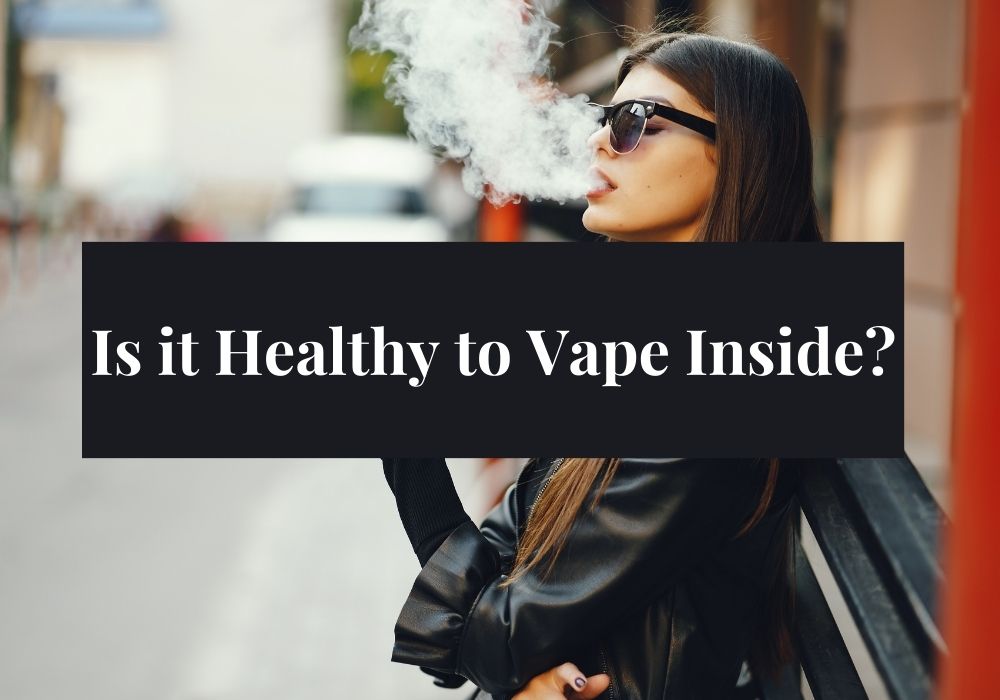Is it Healthy to Vape Inside?

If you’re a vaper, you may be wondering whether it’s healthy to vape indoors. The answer to this question is not straightforward, as it depends on a variety of factors. However, there are some things you should consider before you light up your e-cigarette in your home.
First and foremost, it’s important to understand that vaping is not completely harmless. While it is generally considered to be less harmful than smoking traditional cigarettes, e-cigarettes still contain nicotine and other chemicals that can be harmful to your health. In fact, according to Johns Hopkins Medicine, e-cigarettes heat nicotine, flavorings, and other chemicals to create an aerosol that you inhale. Regular tobacco cigarettes contain 7,000 chemicals, many of which are toxic. So, while vaping may be less harmful than smoking, it’s still not completely safe.
Another important factor to consider is the impact of vaping on indoor air quality. According to IndoorDoctor, vaping can impact your air ducts over time, which can lead to poor indoor air quality. This is because vaping releases aerosols and other particles into the air, which can settle on surfaces and in your air ducts. Over time, this can lead to a buildup of harmful chemicals and particles in your home, which can impact your health. So, if you’re going to vape indoors, it’s important to take steps to limit your exposure to these harmful substances.
Understanding Vaping
What is Vaping?
Vaping is the act of inhaling and exhaling vapor produced by an electronic cigarette or other similar device. Unlike traditional cigarettes, vaping does not involve combustion, which means that there is no smoke produced. Instead, the device heats up a liquid, known as e-juice or vape juice, which is then turned into a vapor that can be inhaled.
SPIRITBAR Katana BP10000
- Slender, leather-textured body reminiscent of a katana handle for an authentic samurai feel
- Unique samurai-inspired e-liquid flavor - fruity yet not too sweet, with a luxurious, elegant aroma
- Powerful 650mAh rechargeable battery for extended vaping time
- Large 18ml e-liquid capacity and 10,000 puff capacity
- Advanced mesh coil and e-liquid & power display screens for optimal vaping experience
The special juice captures the essence of the samurai spirit with its rich, smoothly pulsating flavor that brings new satisfaction with every puff. The device's slender, leather-textured design evokes the grip of a samurai's katana, making this product a perfect choice for beginner vapors.
Components of a Vape
A typical vape device consists of several components, including a battery, a heating element, a tank or cartridge, and e-juice. The battery powers the device, while the heating element, also known as the atomizer, heats up the e-juice and turns it into vapor.
The tank or cartridge holds the e-juice and typically has a wick that absorbs the liquid. The wick is then heated by the atomizer, which turns the liquid into vapor that can be inhaled. Some devices also have adjustable airflow, which allows users to control the amount of vapor they inhale.
It’s important to note that e-juice can contain a variety of ingredients, including nicotine, flavorings, and other chemicals. While vaping is generally considered to be less harmful than smoking traditional cigarettes, it’s still not completely safe. According to Johns Hopkins Medicine, vaping can still expose you to harmful chemicals, including nicotine, heavy metals, and volatile organic compounds (VOCs). Additionally, secondhand vape exposure may also be harmful, as people can inhale the fine particles in vape aerosol, which may have health risks.
SPIRITBAR Jack’s Flask 9000 Puffs
- Stylish pirate flask-shaped body providing an exciting vaping experience
- Delivering up to 9000 puffs per device
- 20ml e-liquid capacity with 50mg nicotine strength for satisfying throat hit
- Specialized pirate-themed e-juice flavors for rich, swirling taste
- Premium mesh coil optimizes flavor profile for maximum vaping enjoyment
This disposable vape captures the daring spirit of the high seas with its flask styling and signature pirate e-juice flavors. The extraordinary battery life provides 9000 indulgent puffs for extended vaping pleasure. Live boldly and freely with the Jack's Flask - a legendary vaping experience fit for a pirate's adventures.
In conclusion, while vaping may be a less harmful alternative to smoking traditional cigarettes, it’s important to understand the components of a vape and the potential risks associated with vaping.
Health Implications of Vaping
If you’re wondering whether it’s healthy to vape inside, you should be aware of the health implications of vaping. While vaping is less harmful than smoking, it’s still not completely safe.
Short-Term Effects
When you vape, you inhale an aerosol that contains nicotine, flavorings, and other chemicals. This can cause short-term effects such as:
- Coughing
- Throat irritation
- Headaches
- Nausea
- Dizziness
Additionally, vaping can increase your heart rate and blood pressure, which can be dangerous if you have a pre-existing heart condition.
Long-Term Effects
The long-term effects of vaping are still being studied, but there is evidence to suggest that vaping can have negative effects on your health. Some potential long-term effects of vaping include:
- Lung damage
- Increased risk of respiratory infections
- Decreased lung function
- Increased risk of heart disease
Furthermore, vaping can be addictive due to the presence of nicotine in e-cigarettes. Nicotine is a highly addictive substance that can lead to dependence and withdrawal symptoms.
In conclusion, while vaping indoors may be convenient, it’s important to consider the potential health implications before doing so. If you’re concerned about the health risks associated with vaping, it’s best to avoid it altogether.
SPIRITBAR Katana BP10000
- Slender, leather-textured body reminiscent of a katana handle for an authentic samurai feel
- Unique samurai-inspired e-liquid flavor - fruity yet not too sweet, with a luxurious, elegant aroma
- Powerful 650mAh rechargeable battery for extended vaping time
- Large 18ml e-liquid capacity and 10,000 puff capacity
- Advanced mesh coil and e-liquid & power display screens for optimal vaping experience
The special juice captures the essence of the samurai spirit with its rich, smoothly pulsating flavor that brings new satisfaction with every puff. The device's slender, leather-textured design evokes the grip of a samurai's katana, making this product a perfect choice for beginner vapors.
Indoor Vaping and Air Quality
If you are a vaper, you may be wondering if it is safe to vape indoors. While vaping is generally considered to be a safer alternative to smoking, there are still concerns about the impact of vaping on indoor air quality. In this section, we will explore the effects of indoor vaping on air quality and secondhand vapor exposure.
Effect on Indoor Air Quality
According to a study by the CDC, the droplets and gases released by e-cigarettes can contain harmful chemicals that can negatively impact indoor air quality. The study found that when a user exhales, a portion of the mixture is released into their surroundings, which can lead to the accumulation of harmful chemicals over time. This can be particularly concerning for people with respiratory issues, such as asthma, as exposure to these chemicals can exacerbate their symptoms.
Another study found that vaping indoors can impact air ducts over time, which can further affect indoor air quality. The study concluded that vaping is not harmless, and it is important to limit exposure to e-cigarette aerosol to protect indoor air quality.
Secondhand Vapor Exposure
Secondhand vapor exposure is another concern when it comes to indoor vaping. While e-cigarette aerosol is generally considered to be less harmful than tobacco smoke, it still contains chemicals that can be harmful to those around you. According to the American Lung Association, secondhand exposure to e-cigarette aerosol can lead to eye, throat, and lung irritation, as well as headaches and nausea.
To minimize the risk of secondhand vapor exposure, it is important to vape in well-ventilated areas, such as outdoors or in designated vaping areas. You should also avoid vaping around children, pregnant women, and people with respiratory issues.
In conclusion, while vaping is generally considered to be a safer alternative to smoking, there are still concerns about the impact of indoor vaping on air quality and secondhand vapor exposure. To protect indoor air quality and minimize the risk of secondhand exposure, it is important to limit exposure to e-cigarette aerosol and vape in well-ventilated areas.
Comparing Vaping to Traditional Smoking
Health Risks Comparison
When it comes to health risks, vaping is generally considered to be less harmful than traditional smoking. According to Johns Hopkins Medicine, vaping does not involve the burning of tobacco, which is the main cause of the harmful chemicals found in cigarette smoke. However, vaping still poses health risks, including:
- Nicotine addiction: Vaping products often contain nicotine, which is highly addictive and can lead to long-term health problems.
- Lung damage: Vaping can cause lung damage, including inflammation and irritation of the airways.
- Chemical exposure: Vaping products can contain harmful chemicals, such as formaldehyde and acetaldehyde, which can cause cancer and other health problems.
On the other hand, traditional smoking is known to cause a wide range of health problems, including lung cancer, heart disease, and stroke. According to the American Cancer Society, smoking is the leading cause of preventable death in the United States.
Indoor Air Quality Comparison
When it comes to indoor air quality, vaping is generally considered to be less harmful than traditional smoking. According to a study published in the Journal of Aerosol Science, vaping produces fewer particulate matter and harmful chemicals than traditional smoking. This means that vaping is less likely to cause indoor air pollution and secondhand smoke.
However, it’s important to note that vaping can still produce some harmful chemicals, such as formaldehyde and acetaldehyde, which can affect indoor air quality. Additionally, vaping can produce a visible aerosol, which can be irritating to some people.
Overall, while vaping is generally considered to be less harmful than traditional smoking, it still poses health risks and can affect indoor air quality. If you choose to vape, it’s important to do so responsibly and in a well-ventilated area.
Regulations and Guidelines
Indoor Vaping Laws
Whether or not you can vape inside depends on where you live. Indoor vaping laws vary from state to state and country to country. Some places allow vaping indoors, while others have banned it completely. For example, in the United States, the FDA regulates vapes and e-cigarettes, and some states have implemented laws that prohibit vaping in certain places, such as schools, public buildings, and restaurants. It is important to check your local laws and regulations before vaping indoors.
Public Health Recommendations
While some places may allow vaping indoors, it is important to consider the potential health risks. The American Lung Association warns that e-cigarettes are not safe and can cause harm to both the user and those around them. Secondhand exposure to e-cigarette aerosol can cause respiratory problems, including coughing, wheezing, and asthma attacks. Some public health experts recommend that vaping be banned indoors to protect the health of non-users.
In addition to potential health risks, there are also concerns about the impact of vaping on indoor air quality. E-cigarette aerosol can contain harmful chemicals, such as formaldehyde and acrolein, which can be released into the air and potentially harm those around them. Some workplaces and public spaces have implemented policies that prohibit vaping indoors to protect the air quality and health of employees and visitors.
Overall, whether or not it is healthy to vape indoors depends on a variety of factors, including local laws and regulations, individual health concerns, and public health recommendations. It is important to consider all of these factors before deciding whether or not to vape indoors.








